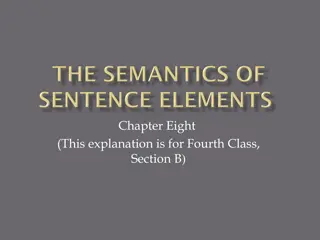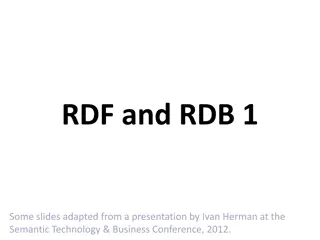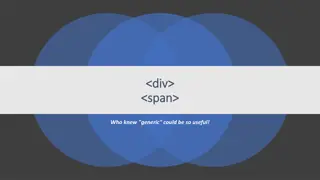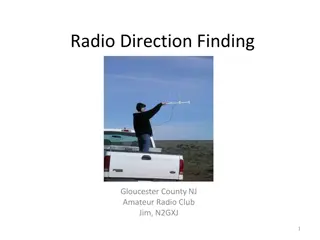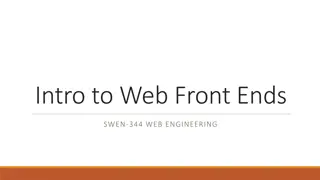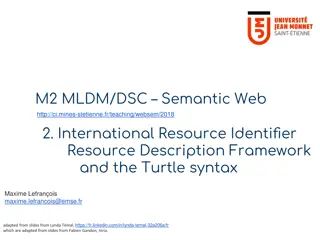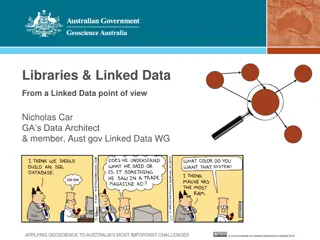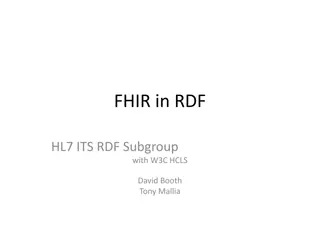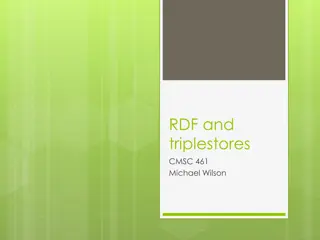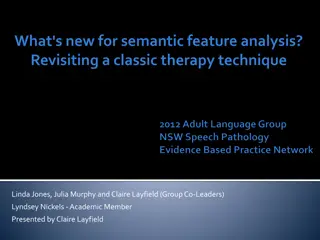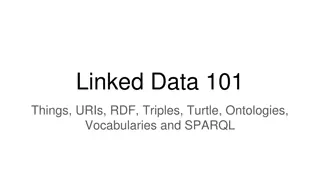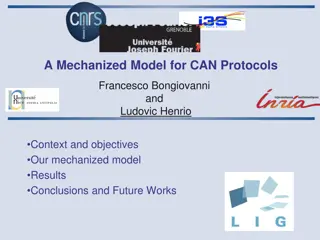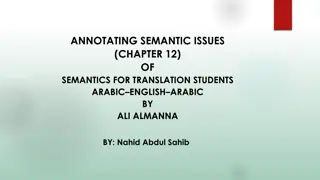Understanding Resource Description Framework (RDF) for Semantic Web
Resource Description Framework (RDF) is a key data model for the Semantic Web, providing a standard way to represent knowledge through subject-predicate-object triples. RDF serves as the foundation for various knowledge representation languages and ontology tools on the web. Through RDF, relationships between resources are captured, forming a labeled, directed graph that aids in information retrieval and processing. Different data formats like RDF/XML, Turtle, and N3 offer varying levels of human-friendliness and tool support for working with RDF data.
Uploaded on Sep 28, 2024 | 0 Views
Download Presentation

Please find below an Image/Link to download the presentation.
The content on the website is provided AS IS for your information and personal use only. It may not be sold, licensed, or shared on other websites without obtaining consent from the author. Download presentation by click this link. If you encounter any issues during the download, it is possible that the publisher has removed the file from their server.
E N D
Presentation Transcript
Resource Description Framework COMP6256 Knowledge Graphs for AI Systems Dr Nicholas Gibbins nmg@ecs.soton.ac.uk
What is the Resource Description Framework? A standard data model for the Semantic Web A knowledge representation language A family of data formats and notations 3 3
A data model Statements in the form of subject-predicate-object triples Typed relationships between resources Collection of RDF statements represents a labeled, directed graph edited by Pat Hayes RDF Semantics object subject predicate 4 4
A knowledge representation language RDF is used as the foundation for the other knowledge representation and ontology languages on the Semantic Web User Interface and Applications Trust Proof Encryption OWL Rules Signature SPARQL (queries) RDF Schema RDF XML + Namespaces URI Unicode 5 5
A family of data formats RDF/XML is the oldest syntax Supported by almost all tools Not in any way human-friendly RDF/N3 family Compact, human-friendly, non-XML syntaxes: N3, NTriples, Turtle We ll concentrate on Turtle in this module Other XML and non-XML syntaxes exist: TriX, JSON-LD, etc 6 6
RDF requirements A means for identifying objects and vocabulary terms A means for distinguishing between terms from different vocabularies A means for serialising triples Herman, I. et al (2015) RDFa 1.1 Primer - Third Edition. W3C Working Group Note. Available at: https://www.w3.org/TR/rdf11-primer 8 8
URIs and URIrefs Standard identifiers for the Semantic Web Uniform Resource Identifiers are defined by RFC3986 http://example.org/ urn:isbn:0198537379 mailto:nmg@ecs.soton.ac.uk URI references (URIrefs) are URIs with optional fragment identifiers http://example.org/index.html#Introduction http://www.w3.org/1999/02/22-rdf-syntax-ns#type Berners-Lee, T. et al (2005) Uniform Resource Identifier (URI): Generic Syntax. RFC3986. Available at https://tools.ietf.org/html/rfc3986 9 9
Namespaces and qualified names RDF syntaxes use namespaces to abbreviate URIs to qualified names (QNames) A QName consists of a namespace prefix, a colon and a local name e.g. rdf:type, dc:creator, foaf:Person Namespace prefixes correspond to URI prefixes For example: Given a namespace prefix of rdffor the URI http://www.w3.org/1999/02/22-rdf-syntax-ns# The QName rdf:type would expand to http://www.w3.org/1999/02/22-rdf-syntax-ns#type 10 10
The N3 family of RDF syntaxes RDF/N3 notation designed by TimBL Concise format suitable for writing by hand RDF/Ntriples defined as part of SPARQL standardisation Used to write test cases for compliance testing RDF/Turtle defined as a simplified version of N3 More faithful to RDF data model Resource URIs are written in angle brackets: <http://example.org> Literal values are written in double quotes: "like this Triples terminated with a full stop: . Whitespace not relevant Beckett, D. et al (2014) RDF 1.1 Turtle: Terse RDF Triple Language, W3C Recommendation. Available at: https://www.w3.org/TR/turtle/ 12 12
Triples in Turtle Literals as objects: <http://www.sciam.com> <http://purl.org/dc/elements/1.1/title> Scientific American . object subject predicate http://www.sciam.com/ Scientific American http://purl.org/dc/elements/1.1/title 13 13
Triples in Turtle Resources as objects: <http://www.sciam.com> <http://purl.org/dc/elements/1.1/creator> <mailto:john@example.org> . http://www.sciam.com/ mailto:john@example.org http://purl.org/dc/elements/1.1/creator 14 14
Namespaces in Turtle Defined using @prefix @prefix dc: < @prefix dc: <http:// http://purl.org purl.org/dc/elements/1.1/> . /dc/elements/1.1/> . <http://www.sciam.com> dc:creator dc:creator <mailto:john @example.org> . note: no angle brackets http://www.sciam.com/ mailto:john@example.org http://purl.org/dc/elements/1.1/creator 15 15
Base URI @base introduces a base URI relative to which all URI fragment identifiers are expanded (similar to use of xml:base in RDF/XML): @base <http:// @base <http://example.org @prefix foaf: <http://xmlns.com/foaf/0.1/> . example.org/data> . /data> . <#john> <#john> foaf:name John Smith . contains the triple: <http:// <http://example.org example.org/ /data#john data#john> > <http://xmlns.com/foaf/0.1/name> John Smith . 16 16
Repeated subjects Use semicolon ; @prefix dc: < http://purl.org/dc/elements/1.1/> . <http://example.org> dc:title "Example Inc. Homepage" ; ; dc:creator <mailto:john @example.org> . . http://purl.org/dc/elements/1.1/title Example Inc. Homepage http://example.org/ mailto:john@example.org http://purl.org/dc/elements/1.1/creator 17 17
Repeated subjects and predicates Use comma , @prefix dc: < http://purl.org/dc/elements/1.1/> . <http://example.org> dc:creator <mailto:john @example.org> , , <mailto:sally@example.org> . dc:creator mailto:sally@example.org http://example.org/ mailto:john@example.org dc:creator 18 18
Blank nodes (bNodes) Sometimes we have resources which we do not wish to identify with a URI These are blank nodes or anonymous resources dc:creator foaf:name http://www.example.org/ John Smith 19 19
Blank nodes (bNodes) @prefix dc: < http://purl.org/dc/elements/1.1/> . @prefix foaf: <http://xmlns.com/foaf/0.1/> . <http://www.example.org/> dc:creator [ [ foaf:name foaf:name John Smith ] John Smith ] . dc:creator foaf:name http://www.example.org/ John Smith 20 20
Blank nodes (bNodes) The [] syntax is insufficient to represent all graphs containing blank nodes unambiguously: @prefix dc: < http://purl.org/dc/elements/1.1/> . @prefix foaf: <http://xmlns.com/foaf/0.1/> . <http://example.org/> dc:creator [ <http://test.example.org/> dc:creator [ [ foaf:name foaf:name John Smith ] John Smith ] . [ foaf:name foaf:name John Smith ] John Smith ] . dc:creator http://example.org John Smith foaf:name http://test.example.org dc:creator 21 21
Blank nodes and node IDs Ambiguities resulting from blank nodes can be resolved by using node IDs Node IDs are identifiers which are local to a given serialisation of an RDF graph Node IDs look like qNames with a namespace prefix of _ (underscore) e.g. _:a123 _:foo _:bar Node IDs may not be referred to from outside the scope of the defining graph Node IDs are not guaranteed to remain unchanged when an RDF file is parsed and serialised The identifier strings may change but The graph structure will remain unchanged 22 22
Blank nodes (bNodes) @prefix dc: < http://purl.org/dc/elements/1.1/> . @prefix foaf: <http://xmlns.com/foaf/0.1/> . <http://example.org/> dc:creator _:foo <http://test.example.org/> dc:creator _:foo _:foo _:foo foaf:name John Smith . _:foo . . _:foo . . dc:creator http://example.org John Smith foaf:name http://test.example.org dc:creator 23 23
Datatypes Literal values presented so far are plain and do not have a type Many applications need to be able to distinguish between different typed literals e.g. integer vs. date vs. decimal RDF uses XML Schema datatypes: @prefix dc: < http://purl.org/dc/elements/1.1/> . @prefix @prefix xsd xsd: <http://www.w3.org/2001/ : <http://www.w3.org/2001/XMLSchema XMLSchema#> . #> . <http://example.org/> dc:date 2020-01-27 ^^ ^^xsd:date xsd:date . 24 24
Multilingual support RDF supports language annotations on literals Languages identified by ISO369-1 two letter codes: en, zh, fr, de, es @prefix dc: < http://purl.org/dc/elements/1.1/> . <http://example.org/foreword> dc:title Foreword @ @en <http://example.org/foreword> dc:title Avant-propos @ @fr en . fr . 25 25
Class membership An object s membership of a class is indicated using the rdf:type property Turtle lets us abbreviate rdf:type with a : @prefix ex: <http://example.org/ontology/> . <http://example.org/> a a ex:Website rdf:type http://example.org/ ex:Website 26 26
The null URI Assertions about the null URIref <> are about the RDF graph itself @prefix dc: < http://purl.org/dc/elements/1.1/> . @prefix xsd: <http://www.w3.org/2001/XMLSchema#> . <> <> dc:date 2022-02-03 ^^xsd:date ; dc:creator <mailto:nmg@ecs.soton.ac.uk> . 27 27
Collections Collections (rdf:List) are a way of expressing ordered groups in RDF Recursive definition a collection consists of the first item in the collection and another collection which is the remainder Resource to represent an empty collection rdf:nil Similar to cons/car/cdr lists in Lisp rdf:first equivalent to car the first item in a collection rdf:rest equivaent to cdr the rest of the collection Immutable cannot be altered without rendering the collection ill-formed Relatively uncommon in plain RDF, but used extensively in the RDF serialisation of OWL (see later lecture) 28
Collections rdf:List rdf:type dc:creator rdf:first http://example.org/ mailto:john@example.org rdf:rest rdf:first mailto:bill@example.org rdf:rest rdf:first mailto:sally@example.org rdf:rest rdf:nil 29
Collections Turtle syntax for collections uses parentheses (): @prefix dc: <http://purl.org/dc/elements/1.1/> . <http://example.org> dc:creator ( < < <mailto:bill@example.org < <mailto:sally@example.org ( <mailto:john@example.org mailto:john@example.org> > mailto:bill@example.org> > mailto:sally@example.org> ) > ) . 30
Collections Possible to write collections without using this syntax (but why would you?) @prefix dc: <http://purl.org/dc/elements/1.1/> . <http://example.org> dc:creator [ rdf:first rdf:rest [ rdf:rest [ rdf:rest [ rdf:type rdf:type rdf:List rdf:first < <mailto:john@example.org mailto:john@example.org> ; rdf:rest [ rdf:first rdf:first < <mailto:bill@example.org mailto:bill@example.org> ; rdf:rest [ rdf:first rdf:first < <mailto:sally@example.org mailto:sally@example.org> ; rdf:rest rdf:nil rdf:nil ] ] ] rdf:List ; ; > ; > ; > ; ] ] ] . 31
Collections Note that these two graphs say fundamentally different things. In this, http://example.org/ has one creator, which is a collection: @prefix dc: <http://purl.org/dc/elements/1.1/> . <http://example.org> dc:creator ( < < <mailto:bill@example.org < <mailto:sally@example.org ( <mailto:john@example.org mailto:john@example.org> > mailto:bill@example.org> > mailto:sally@example.org> ) > ) . In this, http://example.org/ has three creators: @prefix dc: <http://purl.org/dc/elements/1.1/> . <http://example.org> dc:creator < <mailto:john@example.org < <mailto:bill@example.org < <mailto:sally@example.org mailto:john@example.org> , mailto:bill@example.org> , mailto:sally@example.org> > , > , > . 32
RDF Status Original version published in 1999 Working group (RDF Core) formed in April 2001 Revised version published in early 2004 New RDF working group from in 2011 until 2013 New standard syntaxes (Turtle, JSON) Multiple graphs and graph stores 34 34
RDF references RDF homepage at W3C http://www.w3.org/RDF/ RDF 1.1 Primer https://www.w3.org/TR/rdf11-primer/ Turtle specification https://www.w3.org/TR/turtle/ RDF/N3 Primer http://www.w3.org/2000/10/swap/Primer.html XML Schema Part 2: Datatypes http://www.w3.org/TR/xmlschema-2/ 35 35




